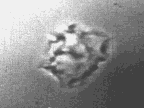
When whole animal cells move, different parts of their bodies carry out different movements. For example, the so-called leading front may ruffle while the trailing end, the so-called tail retracts. When a cell makes a turn, it simply produces a new pseudopodium into the new direction. The figure below shows the typical example of a mouse fibroblast that undergoes dramatic and concerted shape changes as it turns a tail into a front and vice versa. In this way it makes a turn without actually rotating its body as a whole.

How can cells move different parts of their bodies differently? The answer came when we found ways to isolate viable fragments from the periphery of cells which we called 'microplasts'. They were able to move independently. By controlling the actions of each such domain the cells can control the movements of different parts of their body. But, of course, it means that the cells must have a central control system to do that. [See ref 8]


Ruffling microplast
Still, microplasts express extraordinarily complex behavior in their own rights. Compared to 'cell intelligence' it may be considered as the expression of a next lower level of intelligence.
In order to view selected examples, download video sequences that show microplasts that
a. The cell must contain a motor control system that controls the movments of its entire body. It determines when and where its numerous motile domains are allowed to carry out any of their built-in movements. Otherwise, these domains (i.e. cortex domains from which the microplasts were formed) would exercise their autonomy and render the cell incapable of any directional, purposeful movement.
b. The inability of microplasts to restore or create directionality of their movement suggests, that directionality of movement is the product of a higher level of control. Since the directionality of movement responds to obstacles and other unforeseeable events in the path of a moving cell this high level control appears 'intelligent' (i.e. signal integrative and decision-making).